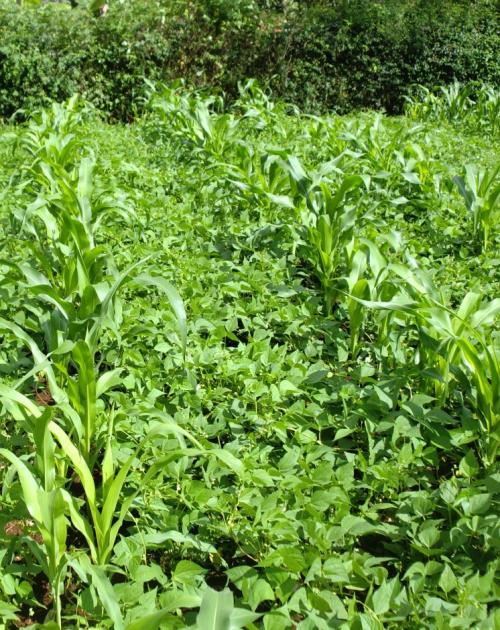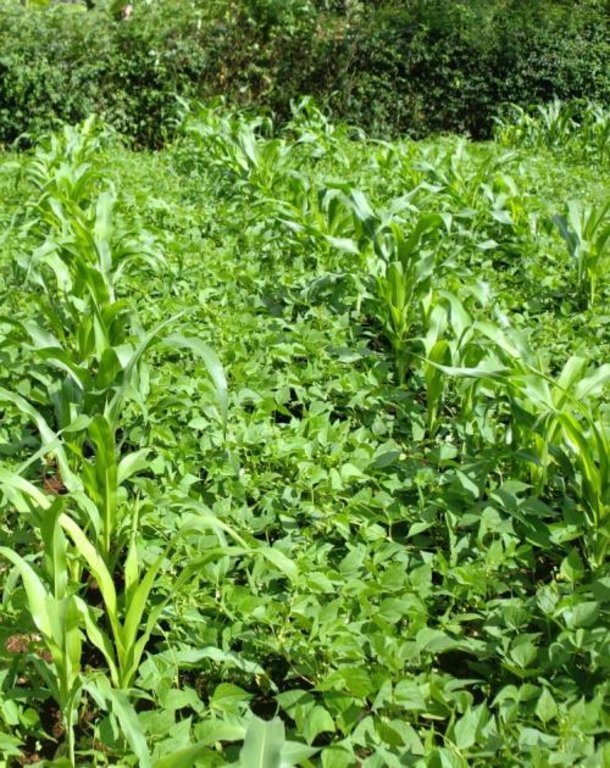Cover crops [肯尼亚]
- 创建:
- 更新:
- 编制者: Paul Kahiga
- 编辑者: –
- 审查者: Fabian Ottiger, Alexandra Gavilano
Cover crops
technologies_1325 - 肯尼亚
查看章节
全部展开 全部收起1. 一般信息
1.2 参与该技术评估和文件编制的资源人员和机构的联系方式
SLM专业人员:
Gathenya Mwangi
Jomo Kenyatta University of Agriculture and Technology
肯尼亚
SLM专业人员:
Home Patrick
Jomo Kenyatta University of Agriculture and Technology
肯尼亚
Chege Timothy
Jomo Kenyatta University of Agriculture and Technology
肯尼亚
SLM专业人员:
Abamba Omwange
Jomo Kenyatta University of Agriculture and Technology
肯尼亚
SLM专业人员:
Baobab Kimengich
Jomo Kenyatta University of Agriculture and Technology
肯尼亚
SLM专业人员:
Wamuongo Jane
Kenya Agricultural Research Institute
肯尼亚
SLM专业人员:
Karanja Andrew
Kenya Agricultural Research Institute
肯尼亚
SLM专业人员:
Namirembe Sara
World Agroforestry Centre (ICRAF)
肯尼亚
有助于对技术进行记录/评估的机构名称(如相关)
International Centre for Research in Agroforestry (ICRAF) - 肯尼亚有助于对技术进行记录/评估的机构名称(如相关)
KARI Headquarters (KARI Headquarters) - 肯尼亚有助于对技术进行记录/评估的机构名称(如相关)
Jomo Kenyatta University (Jomo Kenyatta University) - 肯尼亚1.3 关于使用通过WOCAT记录的数据的条件
编制者和关键资源人员接受有关使用通过WOCAT记录数据的条件。:
是
1.4 所述技术的可持续性声明
这里所描述的技术在土地退化方面是否存在问题,导致无法被认为是一种可持续的土地管理技术?:
否
2. SLM技术的说明
2.1 技术简介
技术定义:
Cover crops are plants seeded into agricultural fields, either within or outside of the regular growing season, with the primary purpose of improving or maintaining ecosystem quality.
2.2 技术的详细说明
说明:
A cover crop is a crop planted primarily to manage soil erosion, soil fertility, soil quality, water, weeds, pests, diseases, biodiversity and wildlife in an agroecosystem,which is an ecological system managed and largely shaped by humans across a range of intensities to produce food, feed, or fiber. Currently, not many countries are known for using the cover crop method.
Purpose of the Technology: Cover crops are of interest in sustainable agriculture as many of them improve the sustainability of agroecosystem attributes and may also indirectly improve qualities of neighboring natural ecosystems. Their purpose include Suppressing weeds, protecting soil from rain or runoff,improving soil aggregate stability,reducing surface crusting, adding active organic matter to soil,breaking hard pan, fixing nitrogen,scavenging soil nitrogen and suppressing soil diseases and pests.
Establishment / maintenance activities and inputs: Cover crops are low-maintenance compared to most crops, but they still need some care. Mowing keeps large cover crops manageable, and sorghum-sudangrass actually increases its root growth if mowed once or twice. White Dutch clover planted in garden pathways needs to be mowed regularly to keep it from competing with vegetables and flowers. Be sure to water cover crops during times of drought.
Natural / human environment: Cover crops are practiced in areas which are prone to soil erosion as areas with steep slope.
2.3 技术照片
2.5 已应用该技术的、本评估所涵盖的国家/地区/地点
国家:
肯尼亚
区域/州/省:
Eastern Province
有关地点的进一步说明:
Mbere South District
具体说明该技术的分布:
- 均匀地分布在一个区域
如果不知道精确的区域,请注明大致覆盖的区域:
- < 0.1 平方千米(10 公顷)
Map
×2.6 实施日期
如果不知道确切的年份,请说明大概的日期:
- 10-50年前
2.7 技术介绍
详细说明该技术是如何引入的:
- 通过土地使用者的创新
3. SLM技术的分类
3.1 该技术的主要目的
- 改良生产
- 减少、预防、恢复土地退化
- 保护生态系统
- 降低灾害风险
- 适应气候变化/极端天气及其影响
- 创造有益的经济影响
3.2 应用该技术的当前土地利用类型

农田
- 一年一作
年作 - 具体指明作物:
- 谷类 - 高粱
- 蔬菜 - 其他
每年的生长季节数:
- 1
注释:
Major land use problems (compiler’s opinion): Excessive evaporation and of available moisture
Major land use problems (land users’ perception): Effective utilization of the available land
3.4 供水
该技术所应用土地的供水:
- 雨养
3.5 该技术所属的SLM组
- 改良的地面/植被覆盖
3.6 包含该技术的可持续土地管理措施

农艺措施
- A1:植被和土壤覆盖层

植物措施
- V2:草和多年生草本植物

结构措施
- S2:堤、岸
注释:
Type of agronomic measures: better crop cover, cover cropping, legume inter-planting
Type of vegetative measures: scattered / dispersed
3.7 该技术强调的主要土地退化类型

土壤风蚀
- Et:表土流失
注释:
Main causes of degradation: soil management
Secondary causes of degradation: deforestation / removal of natural vegetation (incl. forest fires), Heavy / extreme rainfall (intensity/amounts)
3.8 防止、减少或恢复土地退化
具体数量名该技术与土地退化有关的目标:
- 防止土地退化
- 修复/恢复严重退化的土地
4. 技术规范、实施活动、投入和成本
4.1 该技术的技术图纸
技术规范(与技术图纸相关):
The technical drawing on the left hand side shows crops planted in rows and cover crops on the ground covering the soil. The plant to plant spacing and raw to raw spacing depends on the normal crop spacing of individual plants.
Location: Ntharawe. Eastern Province
Date: 12.03.2013
Technical knowledge required for field staff / advisors: moderate (Just little information to demonstrate)
Technical knowledge required for land users: low (Low skills required)
Main technical functions: control of raindrop splash, improvement of ground cover, stabilisation of soil (eg by tree roots against land slides), increase of infiltration, increase / maintain water stored in soil, water spreading, reduction in wind speed
Secondary technical functions: control of dispersed runoff: retain / trap, control of dispersed runoff: impede / retard, reduction of slope angle, increase of groundwater level / recharge of groundwater
Scattered / dispersed
Vegetative material: O : other
Number of plants per (ha): Numerous
Vertical interval between rows / strips / blocks (m): 0.2
Spacing between rows / strips / blocks (m): 0.3
Vertical interval within rows / strips / blocks (m): 0.1
Width within rows / strips / blocks (m): 0.1
Change of land use type: Planting of various types of crops to avoid monocropping
Major change in timing of activities: Proper timing of planting periods of the cover crops to avoid missing of rainy seasons
Control / change of species composition: Use of various cover crop species to enhance nutrient utilization
作者:
Paul Kahiga, 8444-00300 Nairobi
4.2 有关投入和成本计算的一般信息
其它/国家货币(具体说明):
KSh
如相关,注明美元与当地货币的汇率(例如1美元=79.9巴西雷亚尔):1美元=:
100.0
注明雇用劳工的每日平均工资成本:
5.00
4.3 技术建立活动
| 活动 | 时间(季度) | |
|---|---|---|
| 1. | Ploughing | Before onset of rains |
4.4 技术建立所需要的费用和投入
| 对投入进行具体说明 | 单位 | 数量 | 单位成本 | 每项投入的总成本 | 土地使用者承担的成本% | |
|---|---|---|---|---|---|---|
| 劳动力 | Ploughing | ha | 1.0 | 30.0 | 30.0 | 100.0 |
| 设备 | Tools | ha | 1.0 | 3.0 | 3.0 | 100.0 |
| 植物材料 | Seeds | ha | 1.0 | 10.0 | 10.0 | 100.0 |
| 技术建立所需总成本 | 43.0 | |||||
| 技术建立总成本,美元 | 0.43 | |||||
注释:
Duration of establishment phase: 6 month(s)
4.5 维护/经常性活动
| 活动 | 时间/频率 | |
|---|---|---|
| 1. | seeds | each croping season |
| 2. | weeding | each croping season |
| 3. | harvesting | end of the crop season |
| 4. | weeding | After some time after planting |
4.6 维护/经常性活动所需要的费用和投入(每年)
| 对投入进行具体说明 | 单位 | 数量 | 单位成本 | 每项投入的总成本 | 土地使用者承担的成本% | |
|---|---|---|---|---|---|---|
| 劳动力 | Weeding and harvesting | ha | 1.0 | 15.0 | 15.0 | 100.0 |
| 设备 | Tools | ha | 1.0 | 3.0 | 3.0 | 100.0 |
| 植物材料 | Seeds | ha | 1.0 | 10.0 | 10.0 | 100.0 |
| 技术维护所需总成本 | 28.0 | |||||
| 技术维护总成本,美元 | 0.28 | |||||
注释:
Machinery/ tools: hoes, jembes and pangas
4.7 影响成本的最重要因素
描述影响成本的最决定性因素:
Labour is the most determinate factor affecting the costs.
5. 自然和人文环境
5.1 气候
年降雨量
- < 250毫米
- 251-500毫米
- 501-750毫米
- 751-1,000毫米
- 1,001-1,500毫米
- 1,501-2,000毫米
- 2,001-3,000毫米
- 3,001-4,000毫米
- > 4,000毫米
农业气候带
- 半湿润
Thermal climate class: tropics
5.2 地形
平均坡度:
- 水平(0-2%)
- 缓降(3-5%)
- 平缓(6-10%)
- 滚坡(11-15%)
- 崎岖(16-30%)
- 陡峭(31-60%)
- 非常陡峭(>60%)
地形:
- 高原/平原
- 山脊
- 山坡
- 山地斜坡
- 麓坡
- 谷底
垂直分布带:
- 0-100 m a.s.l.
- 101-500 m a.s.l.
- 501-1,000 m a.s.l.
- 1,001-1,500 m a.s.l.
- 1,501-2,000 m a.s.l.
- 2,001-2,500 m a.s.l.
- 2,501-3,000 m a.s.l.
- 3,001-4,000 m a.s.l.
- > 4,000 m a.s.l.
关于地形的注释和进一步规范:
Slopes on average: Gentle (the croplands are gently sloping)
5.3 土壤
平均土层深度:
- 非常浅(0-20厘米)
- 浅(21-50厘米)
- 中等深度(51-80厘米)
- 深(81-120厘米)
- 非常深(> 120厘米)
土壤质地(表土):
- 中粒(壤土、粉土)
土壤质地(地表以下> 20厘米):
- 中粒(壤土、粉土)
表土有机质:
- 中(1-3%)
如有可能,附上完整的土壤描述或具体说明可用的信息,例如土壤类型、土壤酸碱度、阳离子交换能力、氮、盐度等。:
Soil fertility: Medium (classed 1) and high (classed 2)
Soil drainage/infiltration: Good
Soil water storage capacity: Medium
5.4 水资源可用性和质量
地下水位表:
> 50米
地表水的可用性:
中等
水质(未处理):
良好饮用水
5.6 应用该技术的土地使用者的特征
生产系统的市场定位:
- 混合(生计/商业)
非农收入:
- 收入的10-50%
相对财富水平:
- 平均水平
个人或集体:
- 个人/家庭
机械化水平:
- 手工作业
- 畜力牵引
性别:
- 女人
说明土地使用者的其他有关特征:
Land users applying the Technology are mainly common / average land users
Population density: 10-50 persons/km2
Annual population growth: 3% - 4%
5.7 应用该技术的土地使用者使用的平均土地面积
- < 0.5 公顷
- 0.5-1 公顷
- 1-2 公顷
- 2-5公顷
- 5-15公顷
- 15-50公顷
- 50-100公顷
- 100-500公顷
- 500-1,000公顷
- 1,000-10,000公顷
- > 10,000公顷
这被认为是小规模、中规模还是大规模的(参照当地实际情况)?:
- 中等规模的
5.8 土地所有权、土地使用权和水使用权
土地所有权:
- 个人,有命名
土地使用权:
- 个人
用水权:
- 个人
5.9 进入服务和基础设施的通道
健康:
- 贫瘠
- 适度的
- 好
教育:
- 贫瘠
- 适度的
- 好
就业(例如非农):
- 贫瘠
- 适度的
- 好
市场:
- 贫瘠
- 适度的
- 好
能源:
- 贫瘠
- 适度的
- 好
道路和交通:
- 贫瘠
- 适度的
- 好
饮用水和卫生设施:
- 贫瘠
- 适度的
- 好
金融服务:
- 贫瘠
- 适度的
- 好
6. 影响和结论性说明
6.1 该技术的现场影响
社会经济效应
生产
作物生产
生产故障风险
水资源可用性和质量
灌溉用水需求
收入和成本
农业收入
社会文化影响
食品安全/自给自足
SLM/土地退化知识
Improved livelihoods and human well-being
注释/具体说明:
Health
生态影响
土壤
土壤水分
土壤覆盖层
土壤有机物/地下C
6.2 该技术的场外影响已经显现
下游淤积
风力搬运沉积物
6.3 技术对渐变气候以及与气候相关的极端情况/灾害的暴露和敏感性(土地使用者认为的极端情况/灾害)
气候有关的极端情况(灾害)
气象灾害
| 该技术是如何应对的? | |
|---|---|
| 局地风暴 | 好 |
气候灾害
| 该技术是如何应对的? | |
|---|---|
| 干旱 | 不好 |
6.4 成本效益分析
技术收益与技术建立成本相比如何(从土地使用者的角度看)?
短期回报:
积极
长期回报:
积极
技术收益与技术维护成本/经常性成本相比如何(从土地使用者的角度看)?
短期回报:
积极
长期回报:
积极
6.5 技术采用
注释:
There is a strong trend towards spontaneous adoption of the Technology
6.7 该技术的优点/长处/机会
| 编制者或其他关键资源人员认为的长处/优势/机会 |
|---|
| Increase organic matter |
| Reduce soil erosion |
| Increase water infiltration |
| Decrease run off |
| Suppress weeds |
6.8 技术的弱点/缺点/风险及其克服方法
| 编制者或其他关键资源人员认为的弱点/缺点/风险 | 如何克服它们? |
|---|---|
| Difficult to incorporate cover crops with tillage | Use of other pest control measures |
| May increase insect pests |
7. 参考和链接
7.1 信息的方法/来源
- 实地考察、实地调查
- 与土地使用者的访谈
(现场)数据是什么时候汇编的?:
19/09/2012
链接和模块
全部展开 全部收起链接
无链接
模块
无模块





